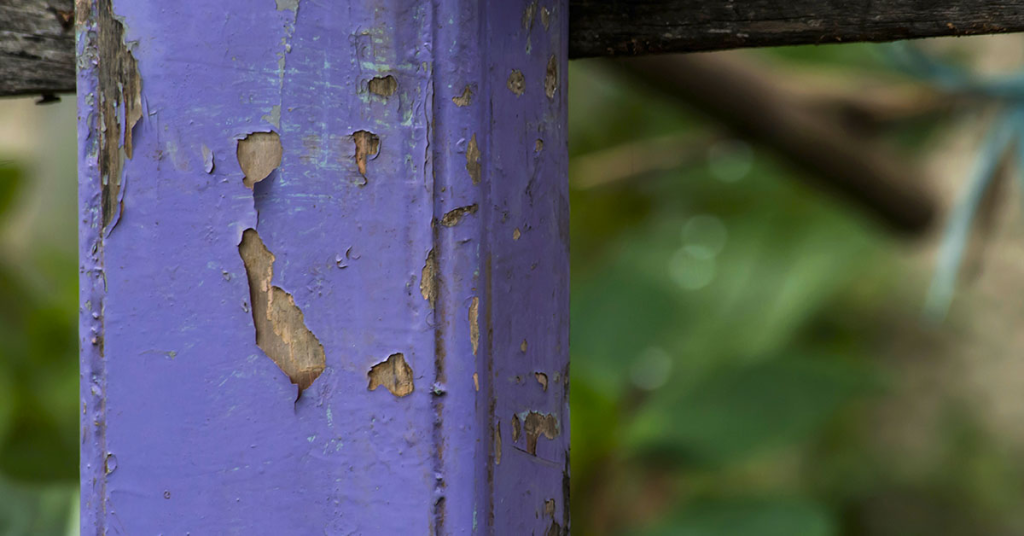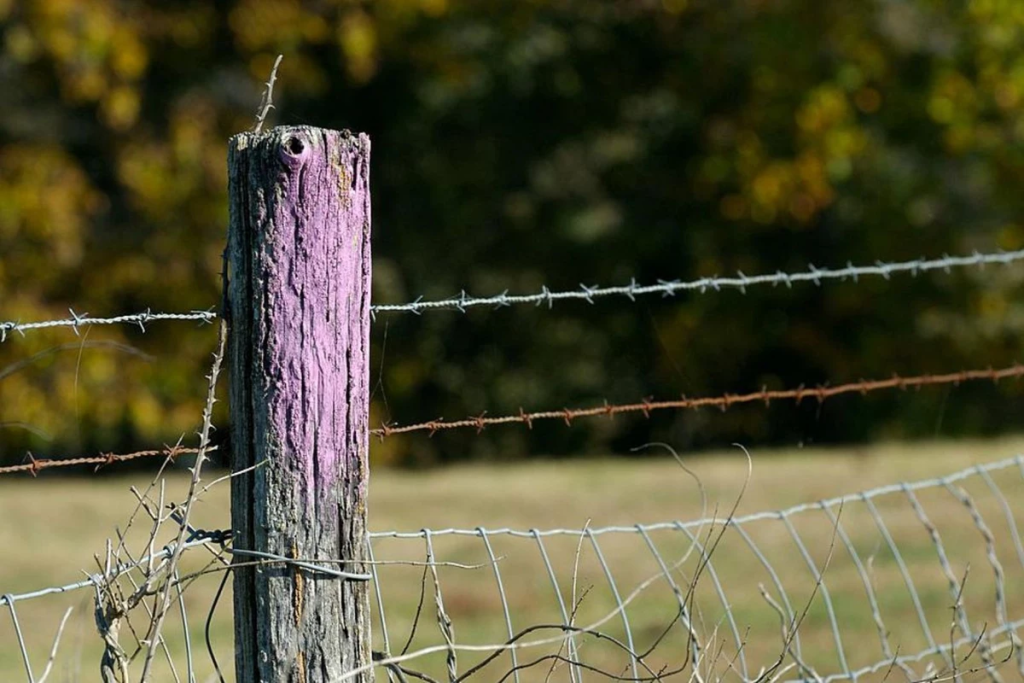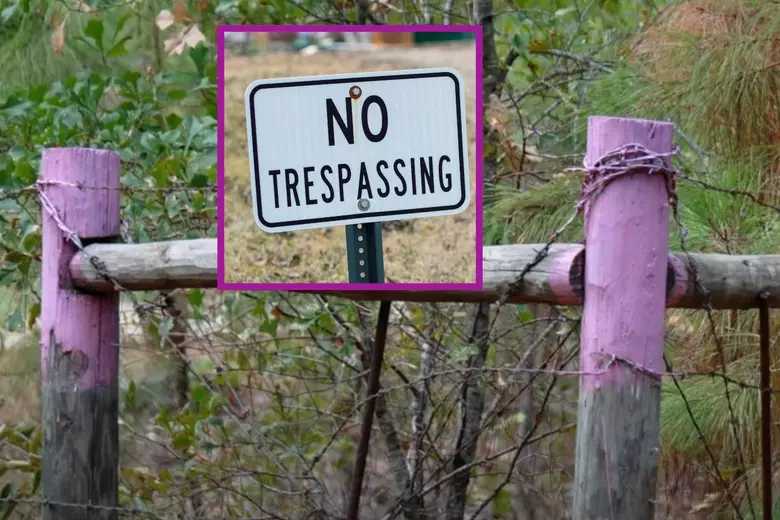You’re hiking through the woods or driving down a rural road when you suddenly spot a fence post or tree painted bright purple. At first, it might seem like an odd choice for decoration—but it’s far more than that. A painted purple fence carries a serious message, and ignoring it could land you in legal trouble.
Many people are unaware that purple paint on a fence or tree serves as a “No Trespassing” sign in many states. This simple but effective method allows landowners to mark their property without the need for traditional metal or wooden signs, which can fade, fall, or be stolen. But why purple? What are the legal implications of crossing a purple-marked boundary? Let’s dive into everything you need to know.

The Meaning Behind a Purple Fence: A Legal Boundary Marker
Purple paint laws exist to inform the public that a piece of land is private property, making it clear that trespassing is not allowed. Instead of relying on signs that can deteriorate over time, landowners can use a coat of purple paint as a permanent, highly visible warning.
Where Did the Purple Paint Law Start?
The first official “Purple Paint Law” was passed in Arkansas in 1989, providing property owners with a durable, cost-effective way to mark their land. Since then, many states have adopted similar laws, recognizing the efficiency and clarity of this system.
Video: If You See Purple Fence Posts, Get Away
Currently, states that have implemented purple paint laws include:
- Texas
- Illinois
- Indiana
- Missouri
- North Carolina
- Florida
- South Carolina
- Tennessee
- Pennsylvania
- Alabama
- Arkansas
- Kansas
- Maine
- Arizona
Some states, like Idaho and Montana, use orange paint instead of purple for the same purpose.
Why Is Purple Paint Used for No Trespassing Signs?

The choice of purple as the official no-trespassing color isn’t random. It was selected for several practical reasons:
- Visibility – Purple stands out against natural backgrounds like trees, grass, and fence posts, making it easy to spot from a distance.
- Colorblind Accessibility – Many people who are colorblind can still recognize purple, ensuring the warning is universally understood.
- Longevity – Unlike traditional no-trespassing signs, purple paint does not fade quickly, is resistant to weather damage, and cannot be easily removed or stolen.
Landowners in states with purple paint laws can use this simple marking system to protect their land, livestock, crops, and personal privacy.
Where You Might Encounter a Purple Fence or Tree
If you spend time in rural areas, whether for hunting, hiking, or sightseeing, you’re likely to come across purple-marked fences or trees. These paint markings are commonly found:
- Along private farmlands and ranches
- At the edges of hunting grounds
- Around vacant private properties
- Near fenced-off forests or woodlands
- Alongside gated driveways or entryways
While some property owners may still post traditional “No Trespassing” signs alongside purple paint, the paint itself is legally recognized as a sufficient warning. That means ignoring it is the same as ignoring a posted sign—and it could come with serious consequences.
What Happens If You Ignore Purple Paint Laws? The Legal Consequences of Trespassing

Some people assume that since there’s no physical barrier, stepping onto purple-marked land isn’t a big deal. However, trespassing on land marked with purple paint can lead to hefty fines and even jail time, depending on the state’s laws.
Potential Legal Penalties for Trespassing on Marked Property
- Misdemeanor charges – Most first-time offenses are considered misdemeanors, carrying fines between $250 and $5,000 and potential jail time of up to six months.
- Felony charges – If a person trespasses with intent to hunt, damage property, or commit a crime, penalties can increase significantly, with potential fines of $10,000 or more and prison sentences of one year or longer.
- Civil lawsuits – Property owners can file civil claims against trespassers for damages, especially if the trespassing results in destruction or harm to crops, livestock, or land.
Ignorance of the law is not a defense. If you see a purple fence, tree, or post, it’s best to turn around—because law enforcement treats it just as seriously as any other no trespassing sign.
How Property Owners Can Properly Use Purple Paint to Mark Their Land
If you’re a landowner looking to use purple paint to mark your property boundaries, it’s important to follow specific guidelines to ensure your markings are legally recognized.
Purple Paint Placement Guidelines
- Use vertical stripes that are at least 1 inch wide and 8 inches long.
- Apply the paint 3–5 feet above the ground for easy visibility.
- Mark trees or fence posts at intervals of no more than 100 feet apart to ensure continuous visibility.
- For trees, use latex-based paint to avoid harming the bark.
These guidelines ensure that trespassers can clearly recognize the markings and understand that the land is private property.
The Importance of Spreading Awareness About the Purple Fence Law

Since the purple paint law is still relatively unknown to many people, landowners and outdoor enthusiasts alike should spread awareness. Education can help prevent accidental trespassing and unnecessary legal troubles.
Here’s how to raise awareness:
- Post information online – Use social media, forums, or community groups to inform others about what a purple fence means.
- Talk to neighbors – If you live in a state with a purple paint law, make sure your local community understands its significance.
- Inform hunters and hikers – Many outdoor lovers aren’t aware of purple paint laws, so educating them can prevent legal issues.
Conclusion: Respect the Color, Respect the Law
A painted purple fence isn’t just a random color choice—it’s a clear legal warning that the land is private and off-limits. Whether you’re hiking, hunting, or exploring the countryside, understanding the meaning of these markings can save you from fines, legal trouble, or conflict with property owners.
If you own land in a state that recognizes the Purple Paint Law, using this method is a smart, cost-effective way to protect your property without worrying about stolen or damaged signs. For those who love the outdoors, staying informed about these laws ensures that every adventure is both safe and legal.
So next time you see a purple-marked tree or fence post, remember: It’s not just paint—it’s the law


